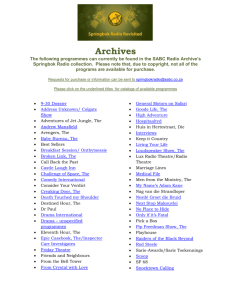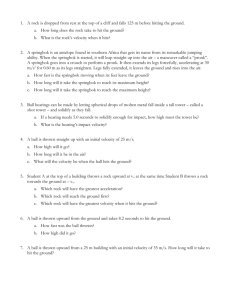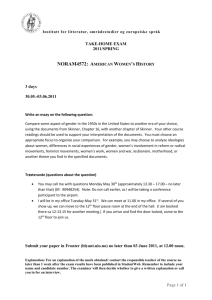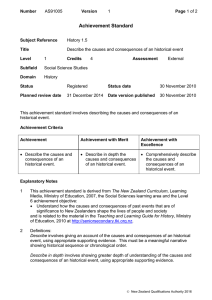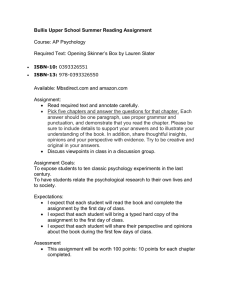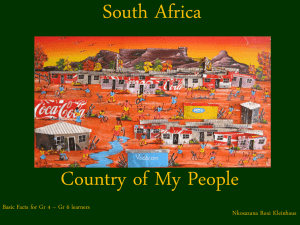Antidorcas marsupialis
advertisement
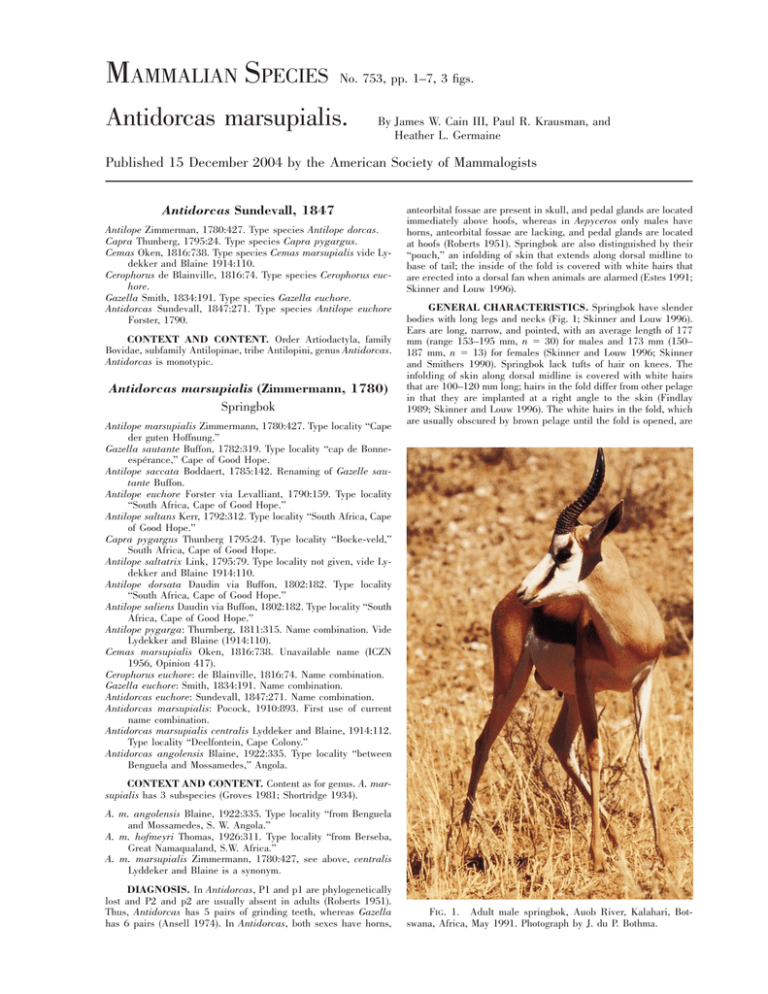
MAMMALIAN SPECIES No. 753, pp. 1–7, 3 figs. Antidorcas marsupialis. By James W. Cain III, Paul R. Krausman, and Heather L. Germaine Published 15 December 2004 by the American Society of Mammalogists Antidorcas Sundevall, 1847 Antilope Zimmerman, 1780:427. Type species Antilope dorcas. Capra Thunberg, 1795:24. Type species Capra pygargus. Cemas Oken, 1816:738. Type species Cemas marsupialis vide Lydekker and Blaine 1914:110. Cerophorus de Blainville, 1816:74. Type species Cerophorus euchore. Gazella Smith, 1834:191. Type species Gazella euchore. Antidorcas Sundevall, 1847:271. Type species Antilope euchore Forster, 1790. CONTEXT AND CONTENT. Order Artiodactyla, family Bovidae, subfamily Antilopinae, tribe Antilopini, genus Antidorcas. Antidorcas is monotypic. Antidorcas marsupialis (Zimmermann, 1780) Springbok Antilope marsupialis Zimmermann, 1780:427. Type locality ‘‘Cape der guten Hoffnung.’’ Gazella sautante Buffon, 1782:319. Type locality ‘‘cap de Bonneespérance,’’ Cape of Good Hope. Antilope saccata Boddaert, 1785:142. Renaming of Gazelle sautante Buffon. Antilope euchore Forster via Levalliant, 1790:159. Type locality ‘‘South Africa, Cape of Good Hope.’’ Antilope saltans Kerr, 1792:312. Type locality ‘‘South Africa, Cape of Good Hope.’’ Capra pygargus Thunberg 1795:24. Type locality ‘‘Bocke-veld,’’ South Africa, Cape of Good Hope. Antilope saltatrix Link, 1795:79. Type locality not given, vide Lydekker and Blaine 1914:110. Antilope dorsata Daudin via Buffon, 1802:182. Type locality ‘‘South Africa, Cape of Good Hope.’’ Antilope saliens Daudin via Buffon, 1802:182. Type locality ‘‘South Africa, Cape of Good Hope.’’ Antilope pygarga: Thurnberg, 1811:315. Name combination. Vide Lydekker and Blaine (1914:110). Cemas marsupialis Oken, 1816:738. Unavailable name (ICZN 1956, Opinion 417). Cerophorus euchore: de Blainville, 1816:74. Name combination. Gazella euchore: Smith, 1834:191. Name combination. Antidorcas euchore: Sundevall, 1847:271. Name combination. Antidorcas marsupialis: Pocock, 1910:893. First use of current name combination. Antidorcas marsupialis centralis Lyddeker and Blaine, 1914:112. Type locality ‘‘Deelfontein, Cape Colony.’’ Antidorcas angolensis Blaine, 1922:335. Type locality ‘‘between Benguela and Mossamedes,’’ Angola. anteorbital fossae are present in skull, and pedal glands are located immediately above hoofs, whereas in Aepyceros only males have horns, anteorbital fossae are lacking, and pedal glands are located at hoofs (Roberts 1951). Springbok are also distinguished by their ‘‘pouch,’’ an infolding of skin that extends along dorsal midline to base of tail; the inside of the fold is covered with white hairs that are erected into a dorsal fan when animals are alarmed (Estes 1991; Skinner and Louw 1996). GENERAL CHARACTERISTICS. Springbok have slender bodies with long legs and necks (Fig. 1; Skinner and Louw 1996). Ears are long, narrow, and pointed, with an average length of 177 mm (range 153–195 mm, n 5 30) for males and 173 mm (150– 187 mm, n 5 13) for females (Skinner and Louw 1996; Skinner and Smithers 1990). Springbok lack tufts of hair on knees. The infolding of skin along dorsal midline is covered with white hairs that are 100–120 mm long; hairs in the fold differ from other pelage in that they are implanted at a right angle to the skin (Findlay 1989; Skinner and Louw 1996). The white hairs in the fold, which are usually obscured by brown pelage until the fold is opened, are CONTEXT AND CONTENT. Content as for genus. A. marsupialis has 3 subspecies (Groves 1981; Shortridge 1934). A. m. angolensis Blaine, 1922:335. Type locality ‘‘from Benguela and Mossamedes, S. W. Angola.’’ A. m. hofmeyri Thomas, 1926:311. Type locality ‘‘from Berseba, Great Namaqualand, S.W. Africa.’’ A. m. marsupialis Zimmermann, 1780:427, see above, centralis Lyddeker and Blaine is a synonym. DIAGNOSIS. In Antidorcas, P1 and p1 are phylogenetically lost and P2 and p2 are usually absent in adults (Roberts 1951). Thus, Antidorcas has 5 pairs of grinding teeth, whereas Gazella has 6 pairs (Ansell 1974). In Antidorcas, both sexes have horns, FIG. 1. Adult male springbok, Auob River, Kalahari, Botswana, Africa, May 1991. Photograph by J. du P. Bothma. 2 MAMMALIAN SPECIES 753—Antidorcas marsupialis FIG. 3. Geographic distribution of Antidorcas marsupialis in southern Africa: 1, A. m. angolensis; 2, A. m. hofmeyri; and 3, A. m. marsupialis. Map adapted from Blaine (1922), Skinner and Louw (1996), and Thomas (1926). Subspecies boundaries are approximate. and A. m. hofmeyri are more similar in size to those of males (Groves 1981). Average body measurements (in mm, range in parentheses) of adult males (n 5 30) and females (n 5 13), respectively, are: total length, 1,501 (1,390–1,623), 1,484 (1,375–1,580); height at shoulder 749, 724; length of tail, 244 (146–286), 256 (200–305); mass (kg), 41 (33–48), 37 (30–44—Skinner and Smithers 1990; Walther 1981). A. m. angolensis has an average height at shoulder of 843 mm for 10 males and 816 mm for 10 females and an average mass of 31 kg for 10 males and 32 kg for 10 females (Skinner and Smithers 1990). A. m. hofmeyri is the largest subspecies, with an average height at shoulder of 857 and 714 mm for 9 males and 9 females, respectively (Skinner and Smithers 1990), and average mass of 42 and 35 kg for 9 males and 13 females, respectively (Skinner and Smithers 1990). A. m. marsupialis is the smallest subspecies, with an average height at shoulder of 749 mm for 21 males and 724 mm for 21 females and an average mass of 31 kg for 21 males and 27 kg for 21 females (Skinner and Smithers 1990). FIG. 2. Dorsal, ventral, and lateral views of skull and lateral view of mandible of adult male Antidorcas marsupialis (Chicago Field Museum, Chicago, Illinois, #34492). Greatest length of skull is 222 mm. Photographs by Y. Petrszyn. raised by arrector pili muscles that lie between the hair follicles (Findlay 1989). Normal-colored springbok of both sexes have a dark reddish-brown band that runs horizontally from upper foreleg to edge of hip and separates darker dorsal area from white underside. Inside of legs, tail (except terminal black tuft), buttocks, and rump are white. Head and face are white in adults with a dark band extending from above eye to corner of mouth and a dark forehead patch; in juveniles, forehead patch and bridge of nose are light brown (Skinner and Louw 1996). Pure black or pure white springbok occur; pure black springbok are ‘‘glossy black’’ when born and become ‘‘chocolate-brown’’ as they mature (Skinner and Louw 1996:16; Smithers 1983). Hooves and horns are black, and both sexes have similarly shaped ringed horns with hooked tips that curve inward (Fig. 2; Estes 1991; Roberts 1951). Horns of females of A. m. marsupialis are thinner (56–65 mm versus 71– 83 mm at base) and usually shorter than in males (163–229 mm versus 229–300 mm), whereas horns of female A. m. angolensis DISTRIBUTION. The current distribution of A. marsupialis is the southwest Arid Zone and dry savanna in southern Africa; the species occurs from the Transvaal west to the Atlantic and north to southern Angola and northern Botswana (Estes 1991; Skinner and Louw 1996; Smithers 1983). Springbok occur throughout most of Namibia. They are widely distributed in South Africa, although introductions make it difficult to determine the distribution of naturally occurring populations (Skinner and Louw 1996; Smithers 1983). The distribution of springbok in Angola is limited to the Namib Desert (Skinner and Louw 1996). A. m. angolensis inhabits northern southwest Africa and Angola, A. m. hofmeyri inhabits southern southwest Africa and Botswana, and A. m. marsupialis inhabits much of South Africa (Fig. 3). FOSSIL RECORD. Fossils of Antidorcas are reported from Pliocene, Pleistocene, and Holocene localities in northern, southern, and eastern Africa (Plug and Peters 1991; Skinner and Louw 1996). Antidorcas evolved from an ancestral Gazella more than 3 million years ago in East Africa and gave rise to Antidorcas australis, A. bondi, and A. recki (Vrba 1973). All 3 ancestral species were widespread in Africa. A. australis and A. bondi became extinct ca. 7,000 years ago, whereas A. marsupialis evolved from A. recki (Vrba 1973). Fossils of A. marsupialis have been found in deposits in Herold’s Bay Cave in Western Cape Province, South Africa, and at Florisbad Spring, Free State Province, South Africa. These deposits are at least 80,000 and 100,000 years old, respectively (Brink 1988; Brink and Deacon 1982). 753—Antidorcas marsupialis MAMMALIAN SPECIES FORM AND FUNCTION. Orbits are prominent, supraorbital foramina are large, and preorbital fossae are small. Nasals are slightly wider at the posterior than in the anterior; anterior nasals are pointed. Premaxilla is wide at posterior but becomes narrow at anterior end. Middle and sides of posterior end of palate approximately equal in length (Roberts 1951). Pterygoids are broad and extend almost to basioccipital and project downward, below palate in anterior end (Roberts 1951). Bullae are small (Roberts 1951). Springbok has a short premolar row; P1 and p1 are absent and P2 and p2, if present, are short and largely nonfunctional and are often shed during adult life (Groves 1981; Skinner and Louw 1996). Milk dentition is i 0/3, c 0/1, p 3/3, total 20 (Skinner and Louw 1996). Adult dentition is reached at 22 months. Dental formula is i 0/3, c 0/1, p 2/2, m 3/3, total 28 (Skinner and Smithers 1990). Preorbital glands do not secrete actively. Dorsal gland at the anterior end of dorsal fold produces a secretion with a strong sweet odor that can be released during pronking and might be used to augment visibility (Bigalke 1972). Springbok have 2 inguinal mammae. Protein, fat, and lactose contents of milk are 8%, 9%, and 5%, respectively (Skinner and Louw 1996). Springbok maintain water balance by drinking water when available, selecting succulent forage, or feeding at night when the rise in humidity increases water content of forage (Nagy and Knight 1994; Taylor 1968). Springbok are adapted to arid environments and can be independent of free water (Skead 1982). During the hot dry season, springbok deprived of drinking water maintain constant body mass and a steady water balance if they are able to consume plants with at least 67% water content (Nagy and Knight 1994), and they might be able to survive on forage with only 10% moisture content (Estes 1991; Smithers 1983). Pelage mean depth is shorter (4.4 mm 6 1.2 SD, n 5 5) and has higher conductance (6.7 W m22 K21) than expected on the basis of body size of springbok (Hofmeyr and Louw 1987). The weighted mean absorbance of springbok pelage is 0.55, with absorbances of 0.28, 0.60, and 0.66 for the white, fawn, and brown areas, respectively; pelage characteristics are likely adaptations to reduce radiant heat absorption and facilitate heat loss after sprinting (Hofmeyr and Louw 1987). Springbok shiver at low ambient temperatures, which might result in a significant loss of energy. Springbok rarely have large fat reserves (Hofmeyr and Louw 1987; Skinner et al. 1971). Despite a lack of efficient insulation because of their short pelage, springbok are able to maintain body temperature within relatively constant limits (37.5–418C—Hofmeyr and Louw 1987). Springbok have a relatively thick kidney medulla (relative medullary thickness 5 5.3 6 0.6 SD, n 5 62), with a high theoretical potential for the kidney to concentrate urine (2,700–3,000 mOsm kg21—Hofmeyr and Louw 1987). However, springbok sampled (n 5 24) from areas with environmental conditions ranging from mesic to xeric had a mean urine osmolality of 1,251 mOsm kg21 6 214 SD (Hofmeyr and Louw 1987). Digestive system is much like other ruminants and is adapted to the springbok’s niche as a mixed dicotyledonous feeder (Skinner and Louw 1996). A few characteristics of the springbok digestive system are adaptations to its arid environment. The rumen has a large amount of internal differentiation, which improves the absorption of water and minerals. The spiral colon is relatively long, constituting 28–32% of the large intestine, and primarily functions in the reabsorption of water and short-chain fatty acids (Hofmann et al. 1996). In addition, nutritional requirements of springbok are unusually low (11.7 kg dry matter kg21 year21—Nagy and Knight 1994). Postcranial skeleton and musculature system are typical of bovids (Skinner and Louw 1996). ONTOGENY AND REPRODUCTION. Springbok are opportunistic breeders and mate year-round. Onset of rains and increased nutritional condition of females might induce estrus (Skinner and Louw 1996). Estrous cycle is ca. 16 days (Skinner and Louw 1996). Springbok females might experience 1 of 3 possible breeding cycles depending on nutritional condition (Skinner and Louw 1996). The 1st is the normal cycle, which consists of a 168day gestation period and 4 months of lactational anestrus (Skinner and Louw 1996). The 2nd possible breeding cycle pertains to females with relatively high nutritional condition; these females can go into postpartum estrus and give birth to 2 lambs in a year (Jackson et al. 1993; Skinner and Louw 1996). The 3rd possible breeding cycle occurs when a lamb dies, in which case the female goes 3 back into estrus 9–15 days thereafter (Jackson et al. 1993; Skinner and Louw 1996). Parturition is often timed so that lambs are born during periods of peak precipitation, when forage conditions are favorable (Bigalke 1970; David 1978a; Jackson et al. 1993; Skinner et al. 1971). Twins are rare; females normally give birth to a single offspring with a mean mass at birth of 3.8–5.0 kg (Skinner and Louw 1996; Walther 1990). Newborn springbok go through a 1- to 2-day period in which neonates remain immobile when approached by a human; consequently, they can be easily captured. After 1–2 days, lambs jump up and run when approached (Bigalke 1972). Initially, mothers graze away from young, which are left hiding for short periods in protected places (e.g., under a bush). Time apart from the mother decreases until lambs are 3 or 4 weeks of age, when they begin to spend most of their time with the maternal herds (Bigalke 1972). Young are weaned after 5–6 months. Young males leave the maternal herd when 6–12 months old to join bachelor herds. In general, separation from the mother corresponds with birth of the next lamb. Young males leave the maternal herds more readily than females, who might remain with the maternal herd indefinitely (Bigalke 1972). Females reach sexual maturity at 6–7 months, whereas males are sexually mature at 2 years (Bigalke 1972; Walther 1990). However, early pregnancy is not common and might be dependent on the female’s body condition and nutritional status (Bigalke 1970). The pregnancy rates are 20% for yearlings (9–10 months old) and 79–94% for adults (Bigalke 1970). ECOLOGY. The springbok is a common plains antelope in the arid lands of southern Africa, occupying a range of landscapes from savannas to the Namib Desert and elevations from the South African High-veld (2,000 m) to sea level (Skinner et al. 1984). Springbok avoid mountains, rocky hills, woodlands, and other areas where vegetation restricts movement and visibility (Bigalke 1972; Smithers 1983). Springbok typically prefer grasslands or savannas with short-growing grasses that are associated with edges of dry lake beds (Bigalke 1972; Milton et al. 1992; Skinner and Smithers 1990). Springbok are seasonal grazers and browsers that shift from grasses in hot, rainy seasons to shrubs in cold, dry seasons (Bigalke 1972; Van Zyl 1965). Springbok feed on a variety of karooid vegetation found along riverbeds and in dry lake beds. Springbok also forage on tall shrubs by standing on their hind legs or eating fallen leaves from the ground, and they occasionally dig for roots (Bigalke 1972; Eloff 1959; Van Zyl 1965). Springbok in the Lombard Reserve, Western Transvaal, feed on 68 plant species, 20 of which are eaten 3 months of the year and are considered primary food plants. These included 9 grasses (Cynodon dactylon, Eragrostis bicolor, E. curvula, E. lehmanniana, E. obtuse, Panicum coloratum, Sporobolus fimbriatus, S. ioclados, and Themeda triandra) and 11 shrubs (Aster muricatus, Cyperus usitatus, Gazania oxyloba, Lycium oxycladum, Nenax microphylla, Nolletia ciliaris, Osteospermum leptolobum, Pentzia calcarea, P. virdis, Salsola rabieana, and Ziziphus mucronata—Van Zyl 1965). Important items in the winter diet of springbok include shrubs (Chrysocoma tenuifolia, Lycium, Pentzia calcarea, P. globosa, P. incana, P. lanata, Rhus ciliata) and trees (Acacia tortilis, Zizyphus mucronata—Bigalke 1972). Important items in the summer diet of springbok include Cymbopogon plurinodis, Cynodon dactylon, C. hirsutus, Eragrostis, Sprobolus, Schmidtia bulbosa, Tragus berteronianus, and Urochloa stolonifera. Fetal sex ratios during years with average climatic conditions are 1:1, but fetal sex ratios can change in response to climatic conditions (Liversidge 1993). Male-biased fetal sex ratios occur during periods with successive years of high rainfall, and femalebiased fetal sex ratios following drought conditions, a pattern that Liversidge (1993) hypothesized might be of selective advantage to ensure high reproductive rates following population declines. Adult sex ratios (males : females) range from 43–57:100 in Estosha and Kalahari Parks, 85:100 in Bontebok Park, and up to 130:100 in Mountain Zebra National Park (Bigalke 1970; David 1978a; Penzhorn 1974). Female-biased adult sex ratios might be the result of sampling error, as a result of misclassification of subadult females as adults, or to higher mortality rates for adult males (Bigalke 1970; David 1978a). Average lifespan of springbok is ca. 10 years (Walther 1990). Springbok aggregate during the summer rainy season in areas with green vegetation and disperse in small groups during the win- 4 MAMMALIAN SPECIES ter dry season. Congregations in summer in small areas with good forage conditions are estimated to contain 1,000–2,200 individuals (Bigalke 1972). Adult springbok are preyed on by cheetahs (Acinonyx jubatus), which are the major predator, caracals (Felis caracal), hyenas (Hyaena brunnea), leopards (Panthera pardus), lions (P. leo), spotted hyenas (Crocuta crocuta), and wild dogs (Lycaon pictus—Hofmeyr and Louw 1987; Skinner and Louw 1996; Walther 1990). Young springbok are additionally preyed on by African wild cats (Felis lybica); black-backed jackals (Canis mesomelas), which are the major predator of fawns; and ratels (Mellivora capensis—Estes 1991; Skinner and Louw 1996; Walther 1990). Lambs are also preyed on by black eagles (Aquila verreauxii), martial eagles (Polemaetus bellicosus), and tawny eagles (A. rapax—Skinner and Louw 1996). External parasites on springbok include lice (Damalinia antidorcas, Linognathus antidorcas, L. armatus, L. bedfordi, L. digitalis, and L. euchore), louse flies (Hippobosca rufipes, Lipoptena sepiacea), nasal bot-flies (Rhinoestrus antidorcitis, R. vanzyli), and ticks (Amblyomma hebraeum, Boophilus decoloratus, Hyalomma marginatum turanicum, H. rufipes, H. truncatum, Ixodes pilosus, I. rubicundus, Margaropus winthemi, Rhipicephalus appendiculatus, R. glabroscutatum, R. evertsi evertsi, R. e. mimeticus, R. follis, and R. nitens—DeVillers et al. 1985; Horak et al. 1982, 1992; Young et al. 1973). Internal parasites of the springbok include nematodes (Agriostomum equidentatum, Brochonema magna, Cooperioides antidorca, Cysticerus tenuicollis, Dictyocaulus magnus, Haemonchus bedfordi, H. contortus, H. krugeri, Longistrongylus albifrontis, L. curvispiculum, L. namaquensis, L. sabie, Nematodirus spathiger, Oesophagostomum africanum, Ostertagia hamata, O. osteragi, Paracooperia serrata, Trichostrongylus axei, T. colubriformis, T. deflexus, T. faculatus, T. thomasi—Boomker et al. 2000; DeVillers et al. 1985; Horak et al. 1982; Young et al. 1973). Diseases that have been recorded in springbok include heartwater and anthrax (Ebedes 1976; Neitz 1944). Ranching of springbok for household and marketable meat has been common since the early 1900s (Skinner and Louw 1996). Mixed herds of springbok and Merino sheep (Ovis aries) are common farming combinations in the Karoo (Davies and Skinner 1986). Springbok are used for venison and skins; springbok meat is very lean with fat content not exceeding 4% (Skinner and Louw 1996). Optimal annual cropping rate is 30% of the animals; however, in years with high rainfall, cropping rate may be increased to 40% (Skinner and Louw 1996). BEHAVIOR. Undisturbed springbok hold the neck slightly forward and angled upward, nose pointed forward and down, and ears upright with pinnae pointed laterally or directed back with pinnae pointed down (Bigalke 1972). Forequarters are positioned lower than hindquarters and tail usually hangs down but can be laid along haunches (Bigalke 1972). When vigilant, springbok hold their necks rigid and erect, ears pointed upward and facing forward, and the tail is wagged (Bigalke 1972). White hairs in the dorsal fold of skin are raised when alarmed. When springbok are ill and during inclement weather, foreand hind legs are held close together with back arched and neck turned downward, ears are laid back, and hair is erect (Bigalke 1972). Springbok rarely take cover under vegetation during rain (Bigalke 1972). Springbok compensate for thin pelage in relation to heat gain behaviorally, reducing their absorption of solar radiation by standing with their highly reflective rump directed toward the sun and the long axis of their body parallel to the direction of the sun, thereby reducing the exposed surface area (Hofmeyr and Louw 1987). Daily activity peaks in early morning and early evening. Most feeding takes place at these times; however, on cool days, springbok might feed throughout the day, and on hot days, they might forage at night during summer (Bigalke 1972; Skinner and Louw 1996). When not feeding, springbok often bed down in the shade of trees and shrubs during summer or bed down in the open during the cooler months (Bigalke 1972; Skinner and Louw 1996). When walking, springbok move forelegs and hind legs on 1 side of the body simultaneously, whereas legs on the other side remain still; the hind foot lands just before forefoot (Bigalke 1972). Trotting includes a high-stepping trot termed ‘‘proud trotting,’’ usually performed in conjunction with head-tossing (Bigalke 1972: 337). Springbok can reach speeds of 88 km/h when galloping. 753—Antidorcas marsupialis When alarmed, springbok leap up to 2 m high; individuals of a herd respond by leaping in different directions and galloping away briefly before slowing to a fast trot (Bigalke 1972). Stotting or pronking comprises several consecutive stiff-legged jumps performed with the back arched, head held low, legs hanging either straight down or bunched together, and white hairs of the dorsal fan erect; it also can involve head-tossing. The animal lands on the ground with all 4 legs at the same time and immediately leaps back in the air in 1 motion; this is repeated several times (Bigalke 1972; Skinner and Louw 1996; Smithers 1983). Stotting is most common in tense situations, but not when fully alarmed, and is a common response to predators. Stotting is also used during play and is commonly observed in females and young that are chased by males during the rut; however, stotting has also been observed in males chased by other males (Bigalke 1972). During the rut, territorial males do not have permanent harems; females are transient on the territories of males and males attempt to herd females that enter their territory (David 1978b). Males grunt loudly, extend their head and neck forward, lay horns back, and hold tail horizontally while approaching females that have entered their territory (Bigalke 1972; David 1978b). Males perform a urination solicitation while standing in the nose-forward position and sniff the perineal region of the female (Bigalke 1972). If the female urinates in response to this display, the male may sniff urine from the ground and perform ‘‘flehmen,’’ a lipcurl display. If the female does not urinate immediately after this display, the male often remains standing in the nose-forward display behind the female for several minutes (David 1978b). The male then takes short steps with stiff forelegs toward the female and points his head at the female’s perineal region. This is usually accompanied by a leg tap, in which the male raises 1 foreleg and moves it laterally a few times without touching the female (Bigalke 1972; David 1978b). This continues until the female urinates or rejects the male by turning sideways or jumping back behind the male (Bigalke 1972; David 1978b). During copulation, the female continues walking while the male copulates with her as he walks bipedally behind her (David 1978b). Solitary males can maintain and defend territories year-round (David 1978b). Territories are generally well spaced; estimates of territory size range from 10 to 40 ha (n 5 15—David 1978b) to 27 to 70 ha (n 5 5—Mason 1976). Territories are usually in open areas, where territorial males visually advertise their status by their presence (Bigalke 1972). Territorial males use ritualized urination– defecation to mark their territories and often have large, conspicuous dung heaps within (Bigalke 1972). Springbok males perform bush-horning, in which a low bush or clump of grass is vigorously thrashed with the horns (Bigalke 1972). Most fighting occurs during rut. Fights between 2 neighboring territorial males are often shorter in duration than fights between a territorial male and a male intruder (Skinner and Louw 1996). Springbok confront each other head on or while standing sideways, and fighting consists of ‘‘front-pressing, lateral twisting, and levering’’ (Estes 1991:83). Stabbing attacks to the body are not uncommon (Walther 1981). The shape of springbok’s horns can result in them becoming locked together during a fight, which can lead to the death of one or both of them (Estes 1991). Springbok are rarely vocal. Contact and maternal calls are short, low-pitched bellows made with slightly opened mouths (Bigalke 1972). Alarmed springbok might produce a high-pitched snort and, when in pain, emit a loud, prolonged grunt (Bigalke 1972:346). Springbok coats are kept in exceptional condition by frequent grooming (Bigalke 1972). Springbok scratch the anterior parts of their body with their hind foot and groom their shoulders, flanks, and hindquarters with the side of their muzzle, incisors, and horns (Bigalke 1972). The springbok is gregarious and has a social organization with a variety of social groups, including harem herds, mixed herds of adults and juveniles, nursery herds, bachelor herds, and solitary males (Bigalke 1970, 1972; David 1978a; Estes 1991). Harem herds, which are composed of 1 adult male and several adult females and young of both sexes, are typical of the rutting period and might be the most important mating groups (Bigalke 1972; David 1978a). After the rut, mixed herds of adult females, young of both sexes, and a varying number of adult males form. Proportion of males (other than lambs) is 22–28% in postrut mixed herds (Bigalke 1970). Onset of lambing disrupts mixed herds as females 753—Antidorcas marsupialis MAMMALIAN SPECIES gather together with their lambs to form nursery herds (Bigalke 1972). Small bachelor herds consist only of mature rams, whereas larger herds consist of a few large adults and a number of juveniles (Bigalke 1972). In general, bachelor herds do not typically inhabit territories, and if they do, they are probably temporary and not as well defined as those of territorial males (Bigalke 1972). In the Kalahari Gemsbok Park, mixed herds ranged from 7 to 182 individuals with a mean of 59 (n 5 14), whereas in Estosha Park, mixed herds ranged from 3 to 90 individuals with a mean of 19 (n 5 32—Bigalke 1970). Bachelor herds ranged from 2 to 50 individuals with groups up to 300 in rare cases (Bigalke 1972). Harem and nursery herds average 10 (n 5 20) and 4 (n 5 6) animals during the rut and 6 (n 5 15) and 7 (n 5 15) during lambing, respectively (David 1978a). Historically, sporadic mass migrations of springbok occurred, typically from arid to more mesic areas (Bigalke 1972; Child and Le Riche 1969; Skinner and Louw 1996). These migrations are commonly referred to as ‘‘trekbokken’’ (Bigalke 1972; Child and Le Riche 1969; Cronwright-Schreiner 1925). Estimates of the number of springbok observed in these migrations range from a few hundred to well over 500,000 (Child and Le Riche 1969; Cronwright-Schreiner 1925; Nowak 1999). These migrations might be dispersal mechanisms that are triggered by poor forage conditions resulting from drought or overgrazing because of high population densities (Child and Le Riche 1969; Skinner and Louw 1996). The speed of treks varies from a steady walk to a run; both sexes and animals of all ages are represented, including pregnant females and newly born lambs that might be abandoned by their mothers (Child and Le Riche 1969). During these migrations, springbok lose much of their customary wariness and often pass though towns where they are shot and clubbed to death by farmers (Child and Le Riche 1969); thousands drown when the trek reaches a river or the ocean (Child and Le Riche 1969; Skinner and Louw 1996). After the passage of a trek, the migration path is severely overgrazed and is often left devoid of plants (Shortridge 1934; Skinner and Louw 1996). Other animals that often join the springbok migrations include domestic sheep, blesbok (Damaliscus dorcas), eland (Taurotragus oryx), hartebeest (Alcelaphus buselaphus), kudu (Tragelaphus strepsiceros), wildebeest (Connochaetes taurinus), zebra (Equus burchelli), and other antelope (Child and Le Riche 1969). GENETICS. All 3 subspecies of A. marsupialis have a monomorphic karyotype, with 2n 5 56 chromosomes (Robinson and Skinner 1976). Autosomal chromosomes pairs 1 and 2 are the largest and are submetacentric, whereas pairs 3 to 27 are acrocentric and exhibit decreasing size. The X chromosome is large and acrocentric, whereas the Y chromosome is small and metacentric (Robinson and Skinner 1976). Populations of springbok have more homozygosity than expected under the Hardy-Weinberg equilibrium (Bigalke et al. 1993; Robinson et al. 1978). High inbreeding coefficients (F 5 0.78 and F 5 0.86) were calculated for samples taken from isolated farm populations that deviated significantly from Hardy-Weinberg; however, free-ranging populations had lower inbreeding coefficients (F 5 0.31—Robinson et al. 1978). CONSERVATION STATUS. Although A. marsupialis still occurs in most of its original northern range, it is much less common (Meester and Setzer 1971; Smithers 1971). Springbok have disappeared from many parts of South Africa within the last 100 years, and many of the remnant populations are isolated on fenced agricultural lands and game reserves (Robinson et al. 1978). Reintroduced populations are resident in many of the parks and reserves of South Africa (de Graaff and Penzhorn 1976; Smithers 1983). The springbok is not listed as an endangered species and is currently not protected under CITES. A 1998 report by the International Union for the Conservation of Nature estimated the total population of springbok in southern and south-central Africa at 670,000 (East 1998). The springbok is considered a lower-risk, conservation-dependent species by the International Union for the Conservation of Nature Antelope Specialist Group (East 1998). REMARKS. The springbok is the national emblem of the Republic of South Africa. The etymology of the name is Greek anti for opposite, dorcas for gazelle, marsupi for pouch, and Latin alis for pertaining to, so A. marsupialis refers to a nongazelle with a dorsal fold of skin. Another vernacular name is springbuck. We thank Y. Petrszyn for photographs of skulls and J. du P. Bothma for the photograph of springbok. P. M. Velaczo obtained 5 skull measurements, and B. Czech assisted with the literature review. LITERATURE CITED ANSELL, W. F. H. 1974. Some mammals from Zambia and adjacent countries. Occasional Papers National Parks and Wildlife Service, Zambia, Supplement 1:1–48. BIGALKE, R. C. 1970. Observations of springbok populations. Zoologica Africana 5:59–70. BIGALKE, R. C. 1972. Observations on the behaviour and feeding habits of the springbok Antidorcas marsupialis. Zoologica Africana 7:333–359. BIGALKE, R. C., G. B. HARTL, M. P. S. BERRY, AND H. J. VAN HENSBERGEN. 1993. Population genetics of the springbok Antidorcas marsupialis—a preliminary study. Acta Theriologica 38 (Supplement 2):103–111. BLAINE, G. 1922. Notes on the zebras and some antelopes of Angola. Proceedings of the Zoological Society of London 1922: 333–336. BODDAERT, P. 1785. Elenchus Animalium, sistens Quadrupedia. C.R. Hake, Roterodami [Rotterdam], The Netherlands 1:1– 174. BOOMKER, J., I. G. HORAK, R. WATERMEYER, AND D. G. BOOYSE. 2000. Parasites of South African wildlife. XVI. Helminths of some antelope species from the eastern and western Cape Provinces. Onderstepoort Journal of Veterinary Research 67: 31–41. BRINK, J. S. 1988. The taphonomy and palaeoecology of the Florisbad spring fauna. Palaeoecology of Africa 19:169–179. BRINK, J. S., AND H. J. DEACON. 1982. A study of a last interglacial shell midden and bone accumulation at Herold’s Bay, Cape Province, South Africa. Palaeoecology of Africa 15:31– 39. BUFFON, G. L. LECLERC, COMPTE DE. 1782. Histoire naturelle, générale et particulière, servant de suite à l’histore des animaux quadrupé, Supplément XI. L’Imprimerie Royale, Paris, France. BUFFON, G. L. LECLERC, COMPTE DE. 1802. Histoire naturelle, générale et particuliére, servant de suite á l’histoire des animaux quadrupeds. P. Didot l’ainé et Firmin Paris, France. CHILD, G., AND J. D. LE RICHE. 1969. Recent springbok treks (mass movements) in south-western Botswana. Mammalia 33: 499–504. CRONWRIGHT-SCHREINER, S. C. 1925. The migratory springboks of South Africa. Fisher Unwin, Ltd., London, United Kingdom. DAVID, J. H. M. 1978a. Observations on social organization of springbok, Antidorcas marsupialis, in the Bontebok National Park, Swellendam. Zoologica Africana 13:115–122. DAVID, J. H. M. 1978b. Observations on territorial behaviour of springbok, Antidorcas marsupialis, in the Bontebok National Park, Swellendam. Zoologica Africana 13:123–141. DAVIES, R. A. G., AND J. D. SKINNER. 1986. Spatial utilisation of an enclosed area of the Karoo by springbok Antidorcas marsupialis and merino sheep Ovis aries during drought. Transactions of the Royal Society of South Africa 46:115–132. DE BLAINVILLE, H. M. 1816. Sur plusieurs espéces d’animaux mammiferes, de l’ordre des ruminans. Paris Société Philomatique Bulletin 3:73–82. DE GRAAFF, G., AND B. L. PENZHORN. 1976. The reintroduction of springbok Antidorcas marsupialis into South African national parks—a documentation. Koedoe 19:75–82. DEVILLERS, I. L., R. LIVERSIDGE, AND R. K. REINECKE. 1985. Arthropods and helminthes in springbok (Antidorcas marsupialis) at Benfontein, Kimberley. Onderstepoort Journal of Veterinary Research 52:1–11. EAST, R. 1998. Antelopes. Global survey and regional action plans. Part 2. Southern and south-central Africa. International Union for the Conservation of Nature and Natural Resources (IUCN), Gland, Switzerland. EBEDES, H. 1976. Anthrax epizootics in wildlife in the Etosha National Park, South West Africa. Pp. 519–526 in Wildlife diseases (L. A. Page, ed.). Plenum, New York. ELOFF, F. C. 1959. Observations on the migration and habits of the antelopes of the Kalahari Gemsbok Park. Part II. Koedoe 2:30–51. ESTES, R. D. 1991. The behavior guide to African mammals. University of California Press, Berkeley. 6 MAMMALIAN SPECIES FINDLAY, G. H. 1989. Development of the springbok skin-colour pattern, hair slope, and horn rudiments in Antidorcas marsupialis. South African Journal of Zoology 24:68–73. GROVES, C. P. 1981. Subspecies and clines in the springbok (Antidorcas). Zeitschrift für Saugetierkunde 46:189–197. HOFMANN, R. R., M. H. KNIGHT, AND J. D. SKINNER. 1996. On structural characteristics and morphophysiological adaptation of the springbok (Antidorcas marsupialis) digestive system. Transactions of the Royal Society of South Africa 50:125–142. HOFMEYR, M. D., AND G. N. LOUW. 1987. Thermoregulation, pelage conductance and renal function in the desert-adapted springbok, Antidorcas marsupialis. Journal of Arid Environments 13:137–151. HORAK, I. G., M. ANTHONISSEN, R. C. KRECEK, AND J. BOOMKER. 1992. Arthropod parasites of springbok, gemsbok, kudus, giraffes and Burchell’s and Hartmann’s zebras in Etosha and Hardap Nature Reserves, Nambia. Onderstepoort Journal of Veterinary Research 59:253–257. HORAK, I. G., D. G. A. MELTZER, AND V. DE VOS. 1982. Helminth and arthropod parasites of springbok, Antidorcas marsupialis, in the Transvaal and western Cape Province. Onderstepoort Journal of Veterinary Research 49:7–10. [ICZN] INTERNATIONAL COMMISSION OF ZOOLOGICAL NOMENCLATURE. 1956. Opinion 417. Rejection for nomenclatural purposes of volume 3 (Zoologie) of the work by Lorenz Oken entitled Okens Lehrbuch der Naturgeschichte published in 1815–1816. Opinions and declarations rendered by the International Commission on Zoological Nomenclature, London, United Kingdom 14:1–42. JACKSON, T. P., J. D. SKINNER, AND P. R. K. RICHARDSON. 1993. Some costs of maintaining a perennial territory in the springbok, Antidorcas marsupialis. African Journal of Ecology 31: 242–254. KERR, R. 1792. The animal kingdom or zoological system, of the celebrated Sir Charles Linnaeus. Class I. Mammalia: containing a complete systematic description, arrangement, and nomenclature, of all the known species and varieties of the Mammalia, or animals which give suck to their young; being a translation of that part of the systema naturae, as lately published, with great improvements, by Professor Gmelin of Goettingen. Together with numerous additions from more recent zoological writers, and illustrated with copperplates. A. Strahan, T. Cadell, and W. Creech, Edinburgh xii 1 l–32 1 30 (unnumbered) 1 33–400 pp., 7 pls. LEVAILLANT, F. 1790. Voyage de M. Le Vaillant dans l’interieur de l’Afrique, par le Cap de Bonne-Espérance, dans les années 1780. Leroy, Paris, France. LINK, H. F. 1795. Beyträge zur Naturgeschichte. Rostock, Leipzig, Germany (not seen, cited in Lydekker and Blaine 1914:110). LIVERSIDGE, R. 1993. Some disproportionate sex ratios in springbok embryos. Pp. 9–11 in Proceedings of a workshop on springbok (J. D. Skinner and H. M. Dott, eds.). Zoological Society of Southern Africa and Eastern Cape Game Management Association, Graaff-Reinet, South Africa. LYDEKKER, R., AND G. BLAINE. 1914. Catalogue of the ungulate mammals in the British Museum. Artiodactyla. Trustees of the British Museum, London, United Kingdom 3:1–283. MASON, D. R. 1976. Some observations on social organization and behaviour of springbok in the Jack Scott Nature Reserve. South African Journal of Wildlife Research 6:33–40. MEESTER, J., AND H. W. SETZER. 1971. The mammals of Africa: an identification manual. Smithsonian Institution Press, Washington, D.C. MILTON, S. J., W. R. J. DEAN, AND C. P. MARINCOWITZ. 1992. Preferential utilization of pans by springbok (Antidorcas marsupialis). Journal of the Grassland Society of South Africa 9: 114–118. NAGY, K. A., AND M. H. KNIGHT. 1994. Energy, water, and food use by springbok antelope (Antidorcas marsupialis) in the Kalahari Desert. Journal of Mammalogy 75:860–872. NEITZ, W. O. 1944. The susceptibility of springbuck (Antidorcas marsupialis) to heartwater. Onderstepoort Journal of Veterinary Science and Animal Industry 20:25–27. NOWAK, R. M. 1999. Walker’s mammals of the world. Johns Hopkins University Press, Baltimore, Maryland. OKEN, L. 1816. Okens Lehrbuch der Naturgeschichte. Zoologie. 753—Antidorcas marsupialis August Schmid und Company Jena, Germany, 3:1–1270 (not seen, cited in Lydekker and Blaine 1914:110). PENZHORN, B. L. 1974. Sex and age composition and dimensions of the springbok (Antidorcas marsupialis) population in the Mountain Zebra National Park. Journal of the Southern African Wildlife Management Association 4:63–65. PLUG, I., AND J. PETERS. 1991. Osteomorphological differences in the appendicular skeleton of Antidorcas marsupialis (Zimmerman, 1780) and Antidorcas bondi (Cooke and Wells, 1951) (Mammalia : Bovidae) with notes on the osteometry of Antidorcas bondi. Annals of the Transvaal Museum 35:253– 263. POCOCK, R. I. 1910. On the specialised cutaneous glands in ruminants. Proceedings of the Zoological Society of London 1910:840–986 ROBERTS, A. 1951. The mammals of South Africa. Trustees of the Mammals of South Africa Book Fund, Johannesburg. ROBINSON, T. J., J. OP’T HOF, AND J. M. P. GEERTHSEN. 1978. Polymorphic markers in the springbok Antidorcas marsupialis (Bovidae). South African Journal of Science 74:184–186. ROBINSON, T. J., AND J. D. SKINNER. 1976. A karyological survey of springbok subspecies. South African Journal of Science 72: 147–148. SHORTRIDGE, G. C. 1934. The mammals of South West Africa. William Heinemann Ltd., London, United Kingdom 2:1–779. SKEAD, C. J. 1982. Historical mammal incidence in the Cape Province. Department of Nature and Environmental Conservation of the Provincial Administration of the Cape of Good Hope, Cape Town, South Africa. SKINNER, J. D., M. V. L. CHEVALLIER, AND J. H. M. VAN ZYL. 1971. An appraisal of the springbok for diversifying animal production in Africa. Animal Breeding Abstracts 39:215–224. SKINNER, J. D., AND G. N. LOUW (EDS.). 1996. The springbok Antidorcas marsupialis (Zimmerman 1780). Transvaal Museum Monographs 10:1–50. SKINNER, J. D., AND R. H. N. SMITHERS. 1990. The mammals of the southern African subregion. University of Pretoria Press, South Africa. SKINNER, J. D., R. J. VAN AARDE, AND A. S. VAN JAARSVELD. 1984. Adaptations in three species of large mammals (Antidorcas marsupialis, Hystrix africaeaustralis, Hyaena brunnea) to arid environments. South African Journal of Zoology 19:82– 86. SMITH, A. 1833–1835. A concise description of the objects of the animal kingdom inhabiting Africa, its islands and seas. South African Quarternary Journal 2:16–32, 49–64, 81–96, 113– 128, 145–160, 169–192, 209–224, 233–248. SMITHERS, R. H. N. 1971. The mammals of Botswana. The Trustees of the National Museums and Monuments of Rhodesia, Museum Memoir, Mardon Printer (Pvt.) Ltd., Salisbury, Rhodesia 4:1–340. SMITHERS, R. H. N. 1983. The mammals of the southern African subregion. University of Pretoria Press, South Africa. SUNDEVALL, C. J. 1847. Methodisk Ofversigt af Idislande djuren, Linnes Pecora. Kungl Vetensk-Akademisch, Handlingar, Stockholm 2:1–330. TAYLOR, C. R. 1968. Hygroscopic food: a source of water for desert antelope? Nature 219:181–182. THOMAS, O. 1926. On mammals from Ovamboland and the Cunene River, obtained during Capt. Shortridge’s third Percy Sladen and Kaffrarian Museum Expedition into south-west Africa. Proceedings of the Zoological Society of London 1926: 285–312. THUNBERG, C. P. 1795. Travels in Europe, Africa, and Asia made between the years 1770 and 1779. Volume 2. Containing two expeditions to the interior part of the country adjacent to the Cape of Good Hope, and a voyage to the island of Java; performed in the years 1773, 1774, and 1775. Second edition. F. and C. Rivington, London, United Kingdom. VAN ZYL, J. H. M. 1965. The vegetation of the S. A. Lombard Nature Reserve and its utilisation by certain antelope. Zoologica Africana 1:55–71. VRBA, E. S. 1973. Two species of Antidorcas Sundevall at Swartkrans (Mammalia: Bovidae). Annals of the Transvaal Museum 28:287–351. WALTHER, F. R. 1981. Remarks on behavior of springbok, Anti- 753—Antidorcas marsupialis MAMMALIAN SPECIES dorcas marsupialis Zimmermann 1790. Der Zoologische Garten 51:81–103 (in German with English summary). WALTHER, F. R. 1990. Gazelles and related species. Pp. 482– 484 in Grzimek’s encyclopedia of mammals (S. P. Parker, ed.). Volume 5, McGraw-Hill Publishing Company, New York. YOUNG, E., F. ZUMPT, P. A. BASSON, B. ERASMUS, P. A. BOYAZOGLU, AND J. BOOMKER. 1973. Notes on the parasitology, pathology, and bio-physiology of springbok in the Mountain Zebra National Park. Koedoe 16:195–198. ZIMMERMANN, E. A. W., VON. 1780. Geographishce Geschichte des Menschen, und der allgemein verbreiteten vierfüssigen Thiere, nebst einer hieher gehörigen zoologischen Welt karte 7 Geographische Geschichte des menschen, und der vierfüssigen Thiere. Zweiter Band. Enthält ein vollständiges verzeichniss aller bekannten Quadrupeden. Weygandschen Buchhandlung, Leipzig, Germany 2:1–432. Associate editors of this account were GAIL MICHENER and PAMELA OWEN. Editor was VIRGINIA HAYSSEN. JAMES W. CAIN III, PAUL R. KRAUSMAN, AND HEATHER L. GERMAINE, SCHOOL OF NATURAL RESOURCES, THE UNIVERSITY OF ARIZONA, TUCSON, ARIZONA 85721, UNITED STATES.
